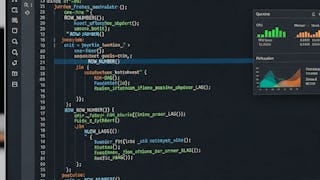- Browse
- Excel Charts
Results for "excel charts"
 Status: Free TrialFree TrialS
Status: Free TrialFree TrialSSimplilearn
Skills you'll gain: Search Engine Marketing, Google Ads, Marketing Analytics, Web Analytics, Google Analytics, Key Performance Indicators (KPIs), Marketing Effectiveness, Performance Measurement, Business Metrics, Online Advertising, Marketing Budgets, Performance Metric, Pay Per Click Advertising, Digital Marketing, Paid media, Search Engine Optimization, Data-Driven Decision-Making, Return On Investment, Marketing Automation, Marketing Strategies
Beginner · Specialization · 1 - 3 Months
 Status: NewNewStatus: Free TrialFree Trial
Status: NewNewStatus: Free TrialFree TrialSkills you'll gain: Oracle SQL Developer, Oracle Databases, Database Design, Data Manipulation, SQL, Relational Databases, Database Management, Databases, Data Transformation, Case Studies, Query Languages, Pivot Tables And Charts, Data Analysis, Performance Tuning, Business Intelligence, Analytics
5·Rating, 5 out of 5 stars14 reviewsBeginner · Specialization · 1 - 3 Months
 Status: NewNewStatus: Free TrialFree Trial
Status: NewNewStatus: Free TrialFree TrialSkills you'll gain: Tableau Software, Dashboard, Data Visualization Software, Data Visualization, R Programming, Alteryx, Statistical Programming, Data Presentation, Interactive Data Visualization, Data Cleansing, Data Storytelling, Data Structures, Statistical Analysis, Workflow Management, Data Analysis, Scatter Plots, Graphing, Data Manipulation, Data Processing, Data Transformation
Intermediate · Specialization · 3 - 6 Months
 Status: Free TrialFree TrialP
Status: Free TrialFree TrialPPackt
Skills you'll gain: Threat Management, Threat Modeling, Vulnerability Assessments, Incident Response, Computer Security Incident Management, Public Key Infrastructure, IT Security Architecture, Disaster Recovery, Vulnerability Management, Regulation and Legal Compliance, Threat Detection, Cyber Security Assessment, Risk Management, Compliance Management, Network Security, Infrastructure Security, Cloud Security, Hardening, Security Engineering, Software-Defined Networking
4.6·Rating, 4.6 out of 5 stars15 reviewsBeginner · Specialization · 1 - 4 Weeks
 Status: Free TrialFree TrialB
Status: Free TrialFree TrialBBoard Infinity
Skills you'll gain: Investment Banking, Financial Services, Banking Services, Insurance, Financial Inclusion, Business Ethics, Insurance Policies, Professional Networking, Bank Regulations, Interviewing Skills, Banking, Compensation Analysis, Finance, Underwriting, Regulatory Compliance, Financial Analysis, Portfolio Management, Financial Planning, Wealth Management, Risk Management
4.2·Rating, 4.2 out of 5 stars13 reviewsBeginner · Specialization · 3 - 6 Months
 Status: NewNewStatus: Free TrialFree Trial
Status: NewNewStatus: Free TrialFree TrialSkills you'll gain: Data-Driven Decision-Making, Project Performance, Constructive Feedback
4.8·Rating, 4.8 out of 5 stars10 reviewsBeginner · Course · 1 - 4 Weeks
 Status: Free TrialFree TrialI
Status: Free TrialFree TrialIIllinois Tech
Skills you'll gain: Database Design, Relational Databases, Database Theory, Data Modeling, Unified Modeling Language, Database Management, Databases, Data Integrity, Dependency Analysis, Conceptual Design, Requirements Analysis
Build toward a degree
3.8·Rating, 3.8 out of 5 stars12 reviewsBeginner · Course · 1 - 4 Weeks
 Status: Free TrialFree TrialL
Status: Free TrialFree TrialLL&T EduTech
Skills you'll gain: Electrical Substation, Electrical Systems, Electrical Wiring, Low Voltage, Electrical Equipment, Electrical Safety, Electrical Power, High Voltage, HVAC, Mechanical Design, Wiring Diagram, Construction, Civil Engineering, Safety Standards, Schematic Diagrams, Engineering Calculations
4.9·Rating, 4.9 out of 5 stars30 reviewsIntermediate · Course · 1 - 3 Months
 Status: PreviewPreviewK
Status: PreviewPreviewKKodeKloud
Skills you'll gain: Git (Version Control System), GitHub, Version Control, Collaborative Software, DevOps, Continuous Integration, File Management, Software Installation
4.7·Rating, 4.7 out of 5 stars26 reviewsBeginner · Course · 1 - 3 Months
 Status: Free TrialFree Trial
Status: Free TrialFree TrialSkills you'll gain: Scaled Agile Framework, Agile Methodology, Backlogs, Kanban Principles, Sprint Retrospectives, Sprint Planning, Project Management Institute (PMI) Methodology, Prioritization, Lean Methodologies, Project Management Life Cycle, Waterfall Methodology, Continuous Integration
4.7·Rating, 4.7 out of 5 stars6 reviewsIntermediate · Course · 1 - 4 Weeks
 Status: PreviewPreviewI
Status: PreviewPreviewIIESE Business School
Skills you'll gain: Professional Networking, Professional Development, Interviewing Skills, Trend Analysis, Sales, Market Trend, LinkedIn, Spreadsheet Software, Relationship Building, Business Marketing, Presentations, Adaptability, Communication Strategies
4.7·Rating, 4.7 out of 5 stars19 reviewsBeginner · Course · 1 - 4 Weeks
 Status: Free TrialFree TrialY
Status: Free TrialFree TrialYYunus Social Business Fund Bengaluru
Skills you'll gain: Finance, Financial Modeling, Financial Acumen, Financial Analysis, Corporate Finance, Business Valuation, Decision Making, Microsoft Excel, Entrepreneurial Finance, Investments, Economics, Policy, and Social Studies, Social Sciences
Beginner · Course · 1 - 3 Months
In summary, here are 10 of our most popular excel charts courses
- ROI-Driven Digital Marketing Analytics: Simplilearn
- Oracle SQL 21c: Database Design & Query Mastery: EDUCBA
- Tableau Data Analysis and Visualization: Packt
- CompTIA CASP+ (CAS-004): Packt
- BFSI Essentials: Unlocking Finance Careers: Board Infinity
- Organize Projects and Measure Productivity with Scrum: Google
- Relational Database Design: Illinois Tech
- MV Substation - An industrial approach (PART-B): L&T EduTech
- Git for beginners with Hands-on Labs: KodeKloud
- Foundations of Agile and Exam Preparation: Packt










